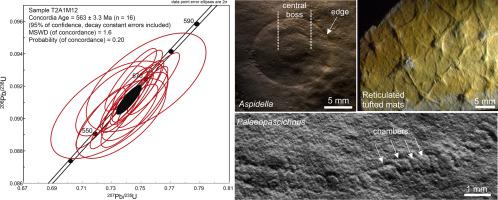当前位置:
X-MOL 学术
›
Gondwana Res.
›
论文详情
Our official English website, www.x-mol.net, welcomes your feedback! (Note: you will need to create a separate account there.)
The oldest record of Ediacaran macrofossils in Gondwana (~563 Ma, Itajaí Basin, Brazil)
Gondwana Research ( IF 6.1 ) Pub Date : 2020-08-01 , DOI: 10.1016/j.gr.2020.03.007 Bruno Becker-Kerber , Paulo Sergio Gomes Paim , Farid Chemale Junior , Tiago Jonatan Girelli , Ana Lucia Zucatti da Rosa , Abderrazak El Albani , Gabriel Ladeira Osés , Gustavo M.E.M. Prado , Milene Figueiredo , Luiz Sérgio Amarante Simões , Mírian Liza Alves Forancelli Pacheco
Gondwana Research ( IF 6.1 ) Pub Date : 2020-08-01 , DOI: 10.1016/j.gr.2020.03.007 Bruno Becker-Kerber , Paulo Sergio Gomes Paim , Farid Chemale Junior , Tiago Jonatan Girelli , Ana Lucia Zucatti da Rosa , Abderrazak El Albani , Gabriel Ladeira Osés , Gustavo M.E.M. Prado , Milene Figueiredo , Luiz Sérgio Amarante Simões , Mírian Liza Alves Forancelli Pacheco

|
Abstract The Avalon biota (Ediacaran Period, 570–559 Ma) marks the first appearance of macroscopic and complex benthic communities in the fossil record. This assemblage is known from a few localities worldwide, mainly in Canada and England. Here, we report for the first time the presence of Ediacaran macrofossils in deposits of similar age from Gondwana (Itajai Basin, southern Brazil). Our new radiometric date (~563 Ma) indicates that the Itajai Basin can be chronocorrelated with the classic Avalonian deposits and thus represents one of the oldest records of the Ediacaran biota in Gondwana. We describe the presence of the Ediacaran genus Palaeopascichnus, as well as discs (Aspidella and Nimbia), and other problematic forms. Contrary to the deep-marine macroorganisms of the Avalon Assemblage, the Itajai fossils are associated with abundant and exceptionally preserved three-dimensional microbial mats and microbially induced sedimentary structures (MISS) in relatively shallow settings (upper slope and distal delta front deposits). In this sense, the Itajai biota could represent early adaptations of benthic macrobiota to the shallower and more photic environments that characterize the later White Sea Assemblage.
中文翻译:

冈瓦纳纪埃迪卡拉纪大型化石的最古老记录(约 563 Ma,巴西伊塔加伊盆地)
摘要 Avalon 生物群(埃迪卡拉纪,570-559 Ma)标志着化石记录中宏观和复杂底栖群落的首次出现。这种组合在世界范围内的一些地方广为人知,主要是在加拿大和英国。在这里,我们首次报告了埃迪卡拉纪大型化石在冈瓦纳(巴西南部 Itajai 盆地)的类似年龄的沉积物中的存在。我们新的辐射测量日期(~563 Ma)表明 Itajai 盆地可以与经典的阿瓦隆沉积物时间相关,因此代表了冈瓦纳大陆埃迪卡拉纪生物群最古老的记录之一。我们描述了 Ediacaran 属 Palaeopascichnus 以及圆盘(Aspidella 和 Nimbia)和其他有问题的形式的存在。与阿瓦隆组合的深海大型生物相反,Itajai 化石与在相对较浅的环境(上斜坡和远端三角洲前缘沉积物)中丰富且保存完好的三维微生物垫和微生物诱导沉积结构(MISS)有关。从这个意义上说,Itajai 生物群可以代表底栖大型生物群对较浅和更光亮的环境的早期适应,这是后来白海组合的特征。
更新日期:2020-08-01
中文翻译:

冈瓦纳纪埃迪卡拉纪大型化石的最古老记录(约 563 Ma,巴西伊塔加伊盆地)
摘要 Avalon 生物群(埃迪卡拉纪,570-559 Ma)标志着化石记录中宏观和复杂底栖群落的首次出现。这种组合在世界范围内的一些地方广为人知,主要是在加拿大和英国。在这里,我们首次报告了埃迪卡拉纪大型化石在冈瓦纳(巴西南部 Itajai 盆地)的类似年龄的沉积物中的存在。我们新的辐射测量日期(~563 Ma)表明 Itajai 盆地可以与经典的阿瓦隆沉积物时间相关,因此代表了冈瓦纳大陆埃迪卡拉纪生物群最古老的记录之一。我们描述了 Ediacaran 属 Palaeopascichnus 以及圆盘(Aspidella 和 Nimbia)和其他有问题的形式的存在。与阿瓦隆组合的深海大型生物相反,Itajai 化石与在相对较浅的环境(上斜坡和远端三角洲前缘沉积物)中丰富且保存完好的三维微生物垫和微生物诱导沉积结构(MISS)有关。从这个意义上说,Itajai 生物群可以代表底栖大型生物群对较浅和更光亮的环境的早期适应,这是后来白海组合的特征。



























 京公网安备 11010802027423号
京公网安备 11010802027423号